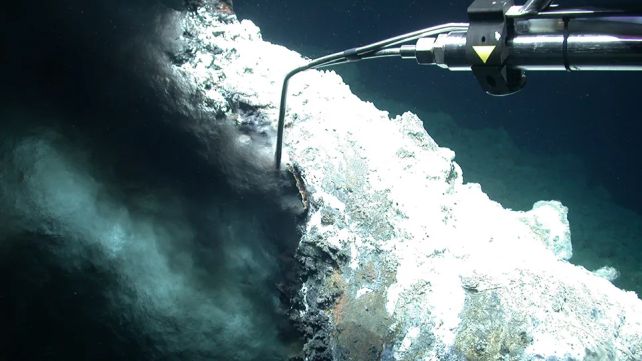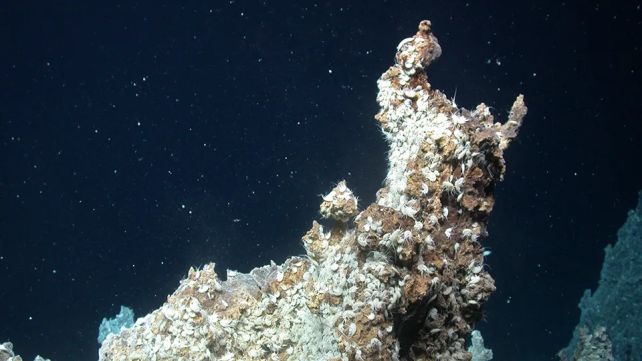ARTICLE AD
A stunning new wonderland has been discovered, hidden deep beneath the ocean waves of the Arctic Circle.
Off the coast of Svalbard, in Norway, more than 3,000 meters (9,842 feet) down, a field of hydrothermal vents unfolds along the Knipovich Ridge, an underwater mountain range previously thought to be fairly unremarkable.
Instead, like underfloor heating, volcanic activity below the seafloor causes heat to seep through, creating havens of warmth and chemical reactions where life can gather and thrive.
The field, measuring at least a kilometer in length and 200 meters in width, has been named Jøtul, for the giants of Norse mythology that live beneath mountains. In this case, the giant is Earth's internal processes, released through cracks in the seafloor.
"Water penetrates into the ocean floor where it is heated by magma. The overheated water then rises back to the sea floor through cracks and fissures," explains marine geologist Gerhard Bohrmann of the University of Bremen in Germany.
"On its way up the fluid becomes enriched in minerals and materials dissolved out of the oceanic crustal rocks. These fluids often seep out again at the sea floor through tube-like chimneys called black smokers, where metal-rich minerals are then precipitated."
 An active black smoker releasing minerals into the water. (MARUM – Center for Marine Environmental Sciences, University of Bremen)
An active black smoker releasing minerals into the water. (MARUM – Center for Marine Environmental Sciences, University of Bremen)Hydrothermal vent fields are some of the most interesting undersea environments. They're usually very deep beneath the ocean surface, so far down that light from the Sun can't penetrate the vast volume of water above them.
At these depths, conditions are permanently dark, freezing cold, and surrounded by crushing pressures.
This environment isn't exactly conducive to life, but hydrothermal vents act as strange oases. The minerals seeping out and dissolving in the water provide the basis for a food web reliant, not on photosynthesis as most life closer to the surface is, but chemosynthesis – harnessing chemical reactions for energy, rather than sunlight.
These environs make for a much more dynamic and thriving deep seafloor than might be expected, giving us a clue about how life might emerge on worlds very different from our own.
Finding hydrothermal fields is important also for trying to protect Earth's biodiversity, and learning more about how it functions, as well as understanding how the planet itself functions and changes over time.
The Jøtul Field is located right on the boundary between two of Earth's tectonic plates, on what is known as a slow spreading ridge. The plates are very slowly moving away from each other, which causes the crust to stretch, and valleys and ridges to develop.
Scientists have detected hydrothermal activity along almost all the ridges north of Iceland, but the Knipovich Ridge remained a glaring exception.
That was, until 2022. Scientists had seen hints of hydrothermal chemistry in the region, so they took a submersible remotely-operated vehicle to the ridge to see if they could find the source of it.
 A chimney vent crawling with amphipods enjoying the warm water. (MARUM – Center for Marine Environmental Sciences, University of Bremen)
A chimney vent crawling with amphipods enjoying the warm water. (MARUM – Center for Marine Environmental Sciences, University of Bremen)They drove the MARUM-QUEST submersible more than 3 kilometers down to the seafloor, where it took images and sampled the waters. And there, they found the Jøtul Field – a large region of seafloor with both extinct and active hydrothermal vents, and the telltale shimmer of volcanic heat seeping into the water.
It's a magnificent find, one that fills in a significant and previously puzzling gap in the hydrothermal layout of the Norwegian-Greenland Sea.
"The Jøtul hydrothermal field is the first to be discovered along the 500-kilometer-long ultraslow-spreading Knipovich Ridge and is significant, because it represents a new link between the active hydrothermal systems of Loki's Castle at the bend of Mohns and Knipovich Ridges and the Aurora hydrothermal field of the Gakkel Ridge," the researchers write in their paper.
"Since these systems are separated by a distance of more than 1,000 kilometers, the discovery of the Jøtul hydrothermal field is important for the understanding of chemosynthetic faunal community distribution."
In addition, the new discovery can help provide insights into ocean chemistry, and how the waters that clothe our world help circulate and distribute material such as carbon.
The research has been published in Scientific Reports.

 4 months ago
30
4 months ago
30 

